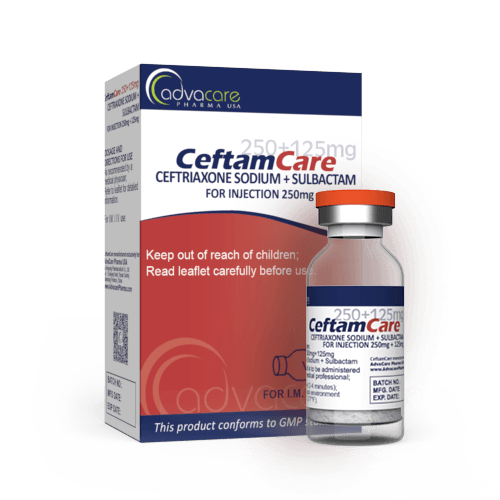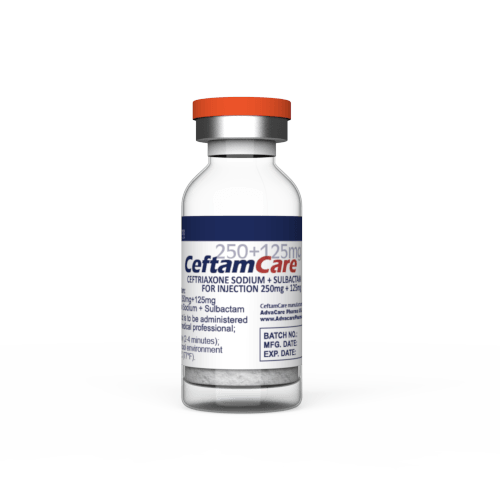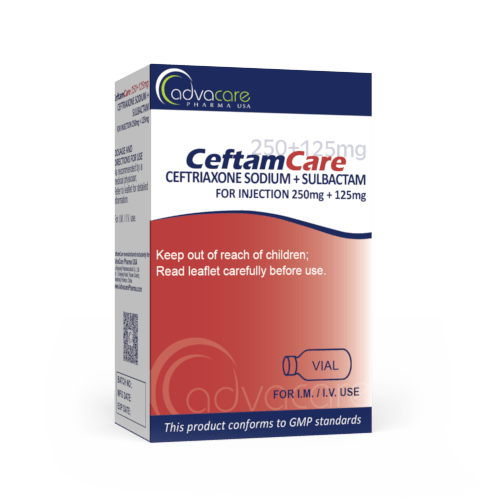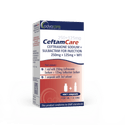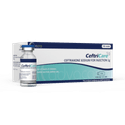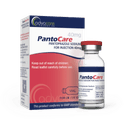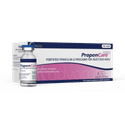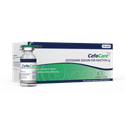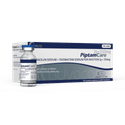- Home›
- Pharmaceuticals›
- Injections›
- Powder for Injection›
- Ceftriaxone + Sulbactam for Injection
Ceftriaxone + Sulbactam for Injection
Dosage
Packaging
What is Ceftriaxone + Sulbactam?
Active Ingredients: Ceftriaxone Sodium, Sulbactam Sodium
Ceftriaxone Sodium + Sulbactam for Injection is a combination antibiotic drug used to treat severe or life-threatening bacterial infections, such as sepsis, meningitis and infections of the bones, joints, soft tissues, skin, or abdomen. It is indicated for infections caused by ceftriaxone-sodium-sensitive pathogens.
Ceftriaxone belongs to the family of antibiotics known as cephalosporins. It is a broad-spectrum bactericidal agent that works by inhibiting the synthesis of peptidoglycans, which form the main component of bacterial cell walls. Ceftriaxone’s beta-lactam functional group binds to penicillin-binding proteins (PBPs) in the bacterial wall and prevents them from synthesizing peptidoglycan, which inhibits cell division and cell wall synthesis and results in bacterial death.
Sulbactam irreversibly inhibits beta-lactamase, which prevents bacterial cells from reducing the activity of antibiotics. Despite having little antibacterial activity, sulbactam can extend the antibacterial spectrum of other antibiotics against beta-lactamase producing strains. Sulbactam’s addition to antibacterial formulations effectively extends the spectrum of antibacterial activity, especially against drug-resistant strains.
This formulation of ceftriaxone sodium + sulbactam has been manufactured as a fine powder for reconstitution, which is available on its own or as a convenient combination pack with Water for Injection. Water for Injection is a diluent in a single-dose container.
Ceftriaxone Sodium + Sulbactam for Injection is produced and exported by AdvaCare Pharma. This medication meets GMP standards and is manufactured in our facilities in China, India, and the USA. We regularly audit our production factories to ensure they comply with WHO guidelines and standards.
Why choose us as your Ceftriaxone + Sulbactam manufacturer?
AdvaCare Pharma, a US-owned pharmaceutical company, is a manufacturer of Ceftriaxone + Sulbactam for Injection with GMP-compliant manufacturing facilities located worldwide. We conduct frequent GMP, third-party and internal facility inspections to ensure that our manufactured injectable treatments exceed the stringent requirements of importing countries and our distributors.
As a renown Ceftriaxone + Sulbactam manufacturer and global supplier of 120+ pharmaceutical injection products, our global reach extends to over 65 markets ensuring that pharmaceutical distributors, hospitals, pharmacies, NGOs and government institutions receive the quality-assured treatments they need.
Uses
What is Ceftriaxone + Sulbactam used for?
It is used to treat bacterial infections, such as:
- ear infections (otitis media)
- lower respiratory tract infections
- skin and skin structure infections
- urinary tract infections
- bone and joint infections
- intra-abdominal infections (e.g. peritonitis, biliary tract infection)
- gonorrhea
- meningitis
- septicemia
How is Ceftriaxone + Sulbactam for Injection used?
This medication is manufactured as a powder, which is to be mixed into a solution. The reconstituted solution is intended for injection via the intravenous (IV) or intramuscular (IM) route.
Injections should only be prepared when they are ready to be used. Ceftriaxone should not be mixed with other antibiotics or any diluent that contains calcium.
This medication should be taken for the full prescribed length of time, even if symptoms improve. Skipping doses or discontinuing treatment prematurely increases the risk of developing infections that are resistant to present and subsequent treatments.
What dose should be given and for how long?
Adults and Children (≥ 12 years) The recommended dosage is between 1g (1g ceftriaxone + 0.5g sulbactam) and 2g (2g ceftriaxone + 1g sulbactam), given once a day or twice in divided doses. The total daily dose of ceftriaxone should not exceed 4g.
Children (1 month - 12 years) The recommended dosage is between 50mg (50mg ceftriaxone + 25mg sulbactam) and 75mg (75mg ceftriaxone + 37.5mg sulbactam) per kg/day, given once a day or twice in divided doses. Daily dosages of ceftriaxone should not exceed 2g.
For the treatment of meningitis in adults and children (≥ 1 month), the recommended initial dose is 100mg/kg, given once a day or twice in divided doses. Daily dosages of ceftriaxone should not exceed 4g.
Treatments should last 4 to 10 days and for at least 10 days when treating infections due to Streptococcus pyogenes. In adults and children (≥ 1 month), IV infusions should be administered over 30 minutes.
The exact dosage is based on the severity of the infections, age, sex, and weight. Refer to a doctor or pharmacist for more guidelines.
Who can use Ceftriaxone and Sulbactam?
Ceftriaxone + sulbactam can be administered to adults and children (≥ 1 month). Special caution is advised for specific groups of patients.
Pregnant Animal studies have not found evidence of fetal harm associated with ceftriaxone administration at doses 20 times the maximum recommended human dose (MHRD).
Studies in pregnant people are inadequate to rule out risk of major birth defects, miscarriage, or adverse maternal or fetal outcomes with ceftriaxone use during pregnancy.
Maternal gonorrhea may be associated with preterm birth, low birth weight, chorioamnionitis, intrauterine growth restriction, small for gestational age, and premature rupture of membranes. Gonorrhea transmitted to neonates during delivery may cause infant blindness, joint infections, and bloodstream infections. In cases of maternal gonorrhea, the benefits of ceftriaxone + sulbactam may outweigh the potential risks.
Animal studies have not found evidence of fetal harm associated with sulbactam + ampicillin administration at doses 10 times the MHRD. Sulbactam does cross the human placenta. Human data spanning many decades have not a relationship between sulbactam + ampicillin use and an increased risk of major birth defects, miscarriage or other adverse maternal or fetal outcomes.
Nursing Ceftriaxone and sulbactam are excreted in human milk in small amounts. The effects on nursing infants are unknown. Caution should be exercised when administering ceftriaxone + sulbactam to nursing patients.
Pediatric Ceftriaxone use is contraindicated in hyperbilirubinemic neonates, especially premature neonates, and those receiving IV infusions containing calcium.
An antibiotic dual-therapy formulation containing sulbactam + ampicillin can be used in children 1 year or older.
Geriatric Clinical studies and reported experiences of ceftriaxone treatment have not observed differences between older adults (≥ 65 years) and younger adults (< 65 years). Clinical studies of sulbactam treatment did not include sufficient numbers of older adults (≥ 65 years) to determine whether they respond differently that younger adults (< 65 years).
Ceftriaxone and sulbactam are primarily excreted renally. Due to age-related decreases in renal function in older patients, the dose should be adjusted based on creatinine clearance, and renal function monitoring is encouraged.
Other warnings
In patients with hepatic insufficiency, dosage adjustments may not be necessary.
In patients with moderate to severe renal insufficiency, dosage reductions may be necessary.
In patients with both hepatic and renal dysfunction, dosages of ceftriaxone should not exceed 2g/day, and close observation is recommended.
Serious and potentially fatal hypersensitivity reactions have been reported with ceftriaxone and other beta-lactam agent use. In cases of severe cross-reactivity reactions, ceftriaxone should be discontinued immediately.
Ceftriaxone can precipitate out of solution if mixed with calcium-containing diluents and when administered through the same IV line. Mixing and simultaneous administration via IV should be avoided.
Ceftriaxone-calcium precipitates have been observed on the sonographies of gallbladders and urinary tracts of patients receiving ceftriaxone. Patients may be asymptomatic or develop symptoms of gallbladder or renal disease. If patients develop signs and symptoms of organ dysfunction or precipitates, ceftriaxone should be discontinued immediately, and symptoms are typically reversible upon treatment cessation.
Clostridium difficile-associated diarrhea (CDAD) has been documented in association with the administration of nearly all antibiotic agents, including ceftriaxone. The severity of CDAD can vary, ranging from mild diarrhea to potentially fatal colitis. Antibiotic treatment disrupts the colonic flora, potentially leading to an overgrowth of C. difficile. Certain strains of C. difficile can contribute to heightened morbidity and mortality. Patients presenting with diarrhea weeks or months post-completion of ceftriaxone therapy should be vigilantly monitored for CDAD. In cases of suspected or confirmed CDAD, the continuation of antibiotics not specifically targeting C. difficile may need to be reconsidered. Comprehensive clinical management should encompass appropriate fluid and electrolyte control, protein supplementation, antibiotic therapy targeting C. difficile, and surgical evaluation when clinically indicated.
Administering ceftriaxone + sulbactam in the absence of a proven or strongly suspected bacterial infection or prophylactic indication is unlikely to provide any clinical benefit and increases the risk of developing drug-resistant bacterial infections.
Cephalosporins, including ceftriaxone, may be associated with an increase in prothrombin time. This risk is increased in patients with renal or hepatic insufficiency, poor nutritional state, those receiving prolonged antimicrobial therapy, and those who are taking anticoagulants. Prothrombin time should be monitored in such patients, and supplemental vitamin K may be administered, if needed.
Side Effects
As with all pharmaceuticals, some unwanted effects can occur from the use of Ceftriaxone Sodium + Sulbactam for Injection.
Common side effects include, but may not be limited to:
- overactive reflexes
- dizziness
- sweating
- headache
- gastrointestinal discomforts (diarrhea, nausea, upset stomach)
- pain or tenderness at injection site
Serious side effects may occur. Seek medical attention if the following develop:
- symptoms indicative of an allergic reaction
- symptoms associated with liver and gallbladder issues
- symptoms suggesting the onset of a new infection
For a comprehensive understanding of all potential side effects, consult a medical professional.
If any symptoms persist or worsen, or you notice any other symptoms, please call your doctor.
Precautions
Do NOT use Ceftriaxone + Sulbactam for Injection if:
- You are allergic to any of the ingredients.
- You have renal or hepatic impairment.
- You have gallbladder pseudolithiasis, pancreatitis, or acute renal failure.
Patients with penicillin hypersensitivity may be predisposed to an allergic cross-reaction.
Colitis may occur during treatment, so caution should be taken in patients with diarrhea.
This medicine is not recommended for neonates and premature infants.
References
In Vitro Microbial Efficacy of Sulbactomax: A Novel Fixed Dose Combination of Ceftriaxone Sulbactam and Ceftriaxone Alone
This study focuses on evaluating the efficacy of the combination of Ceftriaxone Sulbactam and Ceftriaxone alone. Minimum Inhibitory Concentration (MIC) and time-kill curve analysis in Escherichia coli, Pseudomonas aeruginosa, Staphylococcus aureus, Bacillus subtilis, and Klebsiella pneumoniae were evaluated during the study.
The MIC for Ceftriaxone + Sulbactam in E. coli was 0.0625mg/l, while Ceftriaxone alone had an MIC of 0.25mg/l. For S. aureus and P. aeruginosa, the MIC values were 1mg/l for Ceftriaxone + Sulbactam and 2mg/l for Ceftriaxone. There was a significant reduction in MIC values for B. subtilis, decreasing from 32mg/l with Ceftriaxone to 8mg/l with Ceftriaxone + Sulbactam, and for another organism, decreasing from 16mg/l with Ceftriaxone to 2mg/l with Ceftriaxone + Sulbactam.
Time-kill curve analysis demonstrated bacterial maximum killing at 6 hours. Ceftriaxone + Sulbactam demonstrated better bactericidal activity than Ceftriaxone alone.
The conclusion is that a combination of ceftriaxone and sulbactam has more bacterial inhibiting properties than ceftriaxone alone.

You might be interested in...
Why AdvaCare Pharma?
As an industry leader, we are aware of our responsibility to provide affordable and sustainable solutions to improve healthcare worldwide.
